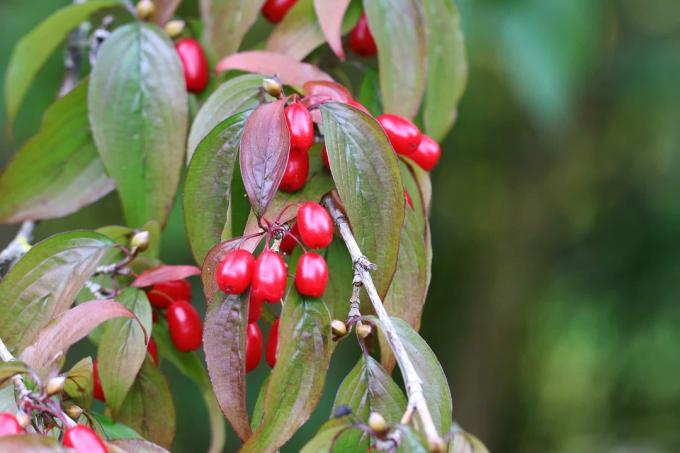
The cornel is a popular wild tree because the flowers are for insects and the fruits are for birds. The fruits of the cornel are not poisonous and are also edible for humans.
In a nutshell
- Cornelian cherry (Cornus mas) is edible in all parts
- Cultivated varieties are more productive than wild varieties
- Fruits rich in valuable ingredients
- non-toxic to dog or horse
- Risk of confusion with the inedible red dogwood (Cornus sanguinea)
Table of contents
- species delineation
- Plant parts used
- Non-toxic to pets
- confusion
- frequently asked Questions
species delineation
The native cornel "Cornus mas" is non-toxic and edible. In addition, Cornus species other than cornel are also commercially available. They are mainly native to Asia, but are only used there for medicinal purposes or as an ornamental shrub.

Other types:
- Cornus officinalis
- Cornus chinensis
- Cornus eydeana
- Cornus volkensii
- Cornus sessilis
If you buy a cornel from a store, make sure it is the edible variety or species. non-toxic variety. Other types are often also offered under the simple designation "Cornelian cherry". With regard to the edibility of other species, there is still no reliable evidence.
The wild form of Cornus mas tends to have smaller fruits. That is why there are new breeds on the market that are significantly more profitable.
Popular cultivars are:
- alosza: variety from Ukraine, yellow fruits
- devin: high-yielding, fruit weight up to 4.5 g
- Jolico: fruit weight up to 6.5 g, small pips, high sugar content
- szafer: high content of vitamin C, fruits almost black
- Mascula: Austrian breed, all-male flowers, ideal as a pollinator variety to increase yield
Tip: Always plant cornelian cherries in company with several perennials. This allows you to significantly increase the yield.
Plant parts used
Finds show that the cornelian cherry was an important food source as early as the Neolithic Age. The fruits, which have a number of valuable ingredients, are mainly used.

ingredients:
- vitamin C
- anthocyanins
- fructose
- fruit acids
- pectin
- iron
- vitamin B
- mucilage
Some historical sources also pick up leaves and bark as a folk medicinal remedy. Leaves and bark, which are rich in tannins, were used.
Tip: The unripe green cornel cherries can be pickled as false olives. For this purpose, the cornelian cherries are doused with a vinegar decoction and then stored in the glass for several weeks.
Non-toxic to pets
The cornel is also non-toxic to animals. For example, if your dog eats the fruit, even a bitten stone does not pose any danger. You can even plant the cornelian cherry along horse pastures without hesitation.
confusion
Botanically, the genus "Cornus" is not yet divided in detail. However, there are demarcations within the genus, at least in German-speaking countries. There you can find, for example Dogwood Species, with which the cornel can be confused. Compared to the non-poisonous Cornus mas, some dogwood species are poisonous. In particular the Red dogwood (Cornus sanguinea) can easily be confused with the cornel.

Characteristics of Red Dogwood:
- red-brown bark
- white flowers
- Flowers grouped into larger pseudo umbels
- Fruits spherical and blue-black
The Red dogwood is at least inedible in all parts. The berries in particular contain flavonoids that can cause stomach problems. Contact with the plant sap, for example through broken leaves, can lead to skin irritation in sensitive people. Children in particular can react strongly to the sap or the berries they eat. If the berries are accidentally eaten by children, you should definitely consult a doctor.
frequently asked Questions
Cornelian cherries are ripe when they are intensely colored and can be easily detached. Some cultivars begin to ripen as early as August. On average, the cornelian cherry harvest season begins in September. Harvesting can take several weeks as the fruit ripens unevenly.
Yes, you can freeze the cornel including the stone. The fruit itself becomes slightly sweeter when frozen. Frozen fruits can later be easily processed into jams, chutneys or juices. A popular delicacy is fruit leather made from cornelian cherries, which has a long shelf life. Freezing is also ideal for collecting larger quantities for processing, as the fruit gradually ripens over a long period of time.
You can plant cornelian cherries in early spring when there is no frost. It is better to plant the plants in autumn, around the end of September. The plants have enough time to take root in the soil before winter comes. In addition, the maintenance effort in autumn is lower because the temperatures are milder and the soil moisture is higher. This reduces the risk of the plants drying out in the rooting phase.



